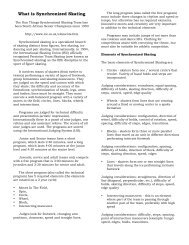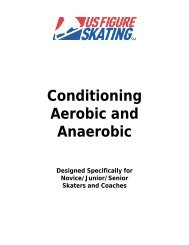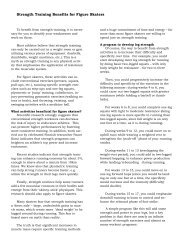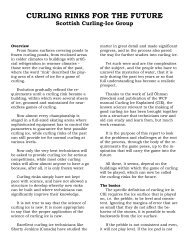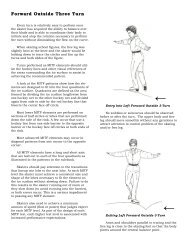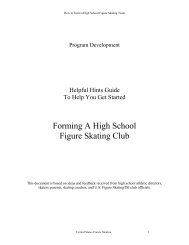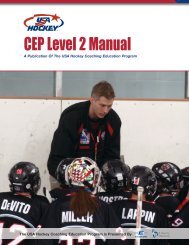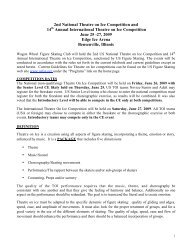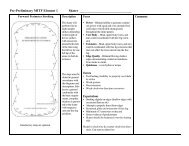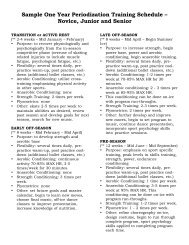ACLs - Ice skating resources
ACLs - Ice skating resources
ACLs - Ice skating resources
Create successful ePaper yourself
Turn your PDF publications into a flip-book with our unique Google optimized e-Paper software.
Anterior Cruciate Ligament (<strong>ACLs</strong>)<br />
Women and girls are more vulnerable to ACL<br />
injuries than men. The anterior cruciate ligament<br />
(ACL) is the most commonly damaged ligament of<br />
the knee, accounting for up to 50% of documented<br />
ligamentous knee injuries. But among women ACL<br />
injury rates are four to eight times higher than for<br />
men. In the US alone, women incur 38,000 ACL<br />
injuries every year. That is significant difference.<br />
In figure <strong>skating</strong> it is accepted that from time to<br />
time a skater will receive up a contact injury from<br />
falling. Many skaters typically wear protective padding<br />
on their knees. However, research shows that<br />
women are not damaging their <strong>ACLs</strong> through contact<br />
injuries.<br />
The leading causes are non-contact mechanisms<br />
such as poor landing strategies, high impact<br />
forces (women generate higher peak impact forces<br />
than men over shorter time frames) and rapid<br />
decelerations.<br />
Researchers in the United States, aware of<br />
these predisposing factors, set about developing<br />
and testing out a ‘prehab’ training program to help<br />
prevent non-contact ACL injuries.<br />
The article Effects of Knee Ligament Injury<br />
Prevention Exercise Program on Impact Forces<br />
In Women was published in The Journal of<br />
Strength and Conditioning Research, Volume 18,<br />
Issue 4 (November 2004), pp. 703–707<br />
Medline Plus – A service of the National Library<br />
of Medicine and the National Institutes of<br />
Health<br />
http://www.nlm.nih.gov/medlineplus/kneeinjurie<br />
sanddisorders.html<br />
Knee Injuries and Disorders<br />
Your knee joint is made up of bone, cartilage,<br />
ligaments and fluid. Muscles and tendons help the<br />
knee joint move. When any of these structures is<br />
hurt or diseased, you have knee problems. Knee<br />
problems can cause pain and difficulty walking.<br />
Arthritis is the most common disease that affects<br />
bones in your knees. The cartilage in the knee<br />
gradually wears away, causing pain and swelling.<br />
Injuries to ligaments and tendons also cause knee<br />
problems.<br />
A common injury is to the anterior cruciate<br />
ligament (ACL). Most individuals injure their ACL<br />
by a sudden twisting motion. ACL and other knee<br />
injuries are common sports injuries.<br />
Treatment of knee problems depends on the<br />
cause. In some cases your doctor may recommend<br />
knee replacement.<br />
http://apt.allenpress.com/perlserv/request=getabstract&doi=10.1519/R-13473.1&ct=1<br />
Twenty-eight female subjects were randomly<br />
assigned into control and treatment groups. The<br />
treatment group took part in two ‘prehab’ training<br />
sessions per week for nine weeks, while the control<br />
group did nothing.<br />
To assess improvements in landing strategies<br />
the scientists looked at ground reaction forces and<br />
rate of force development during a “step land assessment”<br />
(step from a height of 69cm, landing on<br />
a force plate with both feet) before and after the<br />
nine-week training period.<br />
The Medline Plus web site includes information on<br />
the following topics –<br />
Basics<br />
• Overviews<br />
• Latest News<br />
• Diagnosis/Symptoms<br />
• Treatment<br />
• Prevention/Screening
Learn More<br />
• Rehabilitation/Recovery<br />
• Specific Conditions<br />
• Related Issues<br />
Multimedia & Cool Tools<br />
• Health Check Tools<br />
• Tutorials<br />
• Videos<br />
Research<br />
• Clinical Trials<br />
• Research<br />
• Journal Articles<br />
Reference Shelf<br />
• Dictionaries/Glossaries<br />
• Directories<br />
• Organizations<br />
• Statistics<br />
Related Topics<br />
• Knee Replacement<br />
• Leg Injuries and Disorders<br />
• Bones, Joints and Muscles<br />
• Injuries and Wounds<br />
Overviews<br />
• Knee Pain (Mayo Foundation for Medical<br />
Education and Research)<br />
• Questions and Answers about Knee Problems<br />
From the National Institutes of Health<br />
(National Institute of Arthritis and Musculoskeletal<br />
and Skin Diseases)<br />
The Anterior Cruciate Ligament (ACL)<br />
http://en.wikipedia.org/wiki/Anterior_cruciate_lig<br />
ament<br />
The anterior cruciate ligament (ACL) is one of<br />
the four major ligaments of the human knee. In the<br />
quadruped stifle (analogous to the knee), based on<br />
its anatomical position, it is referred to as the cranial<br />
cruciate ligament.[1]<br />
The ACL originates from deep within the notch<br />
of the distal femur. Its proximal fibers fan out<br />
along the medial wall of the lateral femoral condyle.<br />
There are two bundles of the ACL—the anteromedial<br />
and the posterolateral, named according<br />
to where the bundles insert into the tibial plateau.<br />
The ACL attaches in front of the intercondyloid<br />
eminence of the tibia, being blended with the anterior<br />
horn of the lateral meniscus. These attachments<br />
allow it to resist anterior translation of the<br />
tibia, in relation to the femur.<br />
Anterior cruciate ligament injury is the most<br />
common knee ligament injury especially in athletes.<br />
Causes of injury<br />
The ACL is the most commonly injured knee<br />
ligament [2] and is commonly damaged by athletes.<br />
The ACL is often torn during sudden dislocation,<br />
torsion, or hyperextension of the knee. Commonly<br />
patients report hearing or feeling a "pop", but many<br />
report minimal pain at the time of ACL rupture.<br />
In the hours following ACL rupture, however,<br />
most patients notice progressive swelling (usually<br />
due to bleeding of the vessels along the torn ACL).<br />
This swelling generally is quite painful, but can be<br />
minimized by icing the knee.<br />
ACL tears typically occur in sports where cutting,<br />
twisting, and turning are common, such as<br />
Skiing, Gymnastics, American Football, and Soccer.<br />
The most common causes of ACL rupture can<br />
be divided into three major classifications:<br />
• environmental<br />
• anatomical<br />
• hormonal [3]<br />
Environmental causes<br />
Sports which include running and jumping<br />
pose the most potential for injury to the athlete.<br />
The risk for rupture of the anterior cruciate ligament<br />
does not increase in contact sports (as opposed<br />
to noncontact sports).<br />
Anatomical causes<br />
ACL injuries are especially common in female<br />
athletes, due to many possible contributing factors.<br />
The most prevalent explanation relates to female<br />
athletes tending to land more straight-legged<br />
than men, removing the quadriceps' muscles<br />
shock-absorbing action on the knee. Often the<br />
knee on a straight leg can't withstand this and<br />
bends sideways.<br />
Hormonal causes<br />
High levels of specific hormones have been associated<br />
with an increased risk of ACL rupture.<br />
Estrogen is one of these hormones. Some anatomical<br />
and hormonal causes (such as high levels of<br />
estrogen) may put women at a higher risk for injury.[3]<br />
Women and ACL tears<br />
Statistics show that females are now more than<br />
8 times as likely to tear their ACL than male athletes.<br />
Statistics also show that female athletes have
a 25% chance of tearing their ACL a second time<br />
after having the reconstruction surgery done. Differences<br />
between the sexes in hormones, adolescence,<br />
ligament dominance and quadriceps dominance,<br />
biomechanics, anatomy, asymmetry, and<br />
psychology all may contribute to this anomaly.<br />
Main Reason For Female ACL Tears<br />
As a result of the increased angle formed by a<br />
woman's hips and her knees, the ligaments are<br />
constantly under more pressure than a man's.<br />
Adolescents<br />
Young girls aren't as likely to tear their <strong>ACLs</strong> as<br />
young women, because their hips have not widened<br />
more than a boy's of the same age. According<br />
to Anna Kessel, when puberty occurs this changes<br />
the risk of women tearing their ACL from 2 times to<br />
4 times more than men.<br />
Ligament and quadriceps dominance<br />
Women's bodies tend to work in a way that<br />
uses the ligaments more than it uses muscles.<br />
When ligaments are compensating for muscles, it<br />
makes the ligaments weak and more susceptible to<br />
damage.[4]<br />
Male athletes are more likely to use their hamstrings<br />
instead of their ligaments for stability. Instead<br />
of using their hamstrings, women tend to<br />
use their quadriceps, which compresses the joint<br />
and pulls the tibia forward. Doing this can cause<br />
damage or stress on the Anterior Cruciate Ligament.<br />
The quadriceps are made up of four muscles<br />
that help straighten the knee. [5] When an athlete<br />
tears an ACL and has reconstruction surgery, the<br />
quadriceps are one of the most important muscles<br />
to strengthen at therapy.<br />
Biomechanics<br />
Women's bodies are shaped in a such a way<br />
that when they are jumping, pivoting, and landing,<br />
their knees are likely to bend inward. Doing so distributes<br />
the weight unevenly throughout the<br />
woman’s body.<br />
Scientists also suggest that the difference in<br />
men’s and women's femoral notch may be another<br />
reason women tear their ACL more often than men.<br />
The femoral notch - the space at the bottom of the<br />
femur, where the ACL runs - is narrower in women<br />
than in men. It is suggested that since the<br />
woman’s femoral notch is smaller, the femur<br />
grinds the ACL and can make it weaker.<br />
Another biomechanic that is said to likely<br />
cause ligament damage is the quadriceps femoris<br />
muscle angle, also known as the “Q-Angle”. The Q-<br />
Angle is larger in women's bodies than men's, because<br />
of their larger pelvises. The female’s ACL is<br />
shaped slightly differently than a male’s; it is also<br />
slightly smaller, according to Dr. Jonathan C. Cluett,<br />
M.D., a board certified orthopedic surgeon in<br />
Massachusetts, USA.<br />
Diagnosis<br />
Several diagnostic maneuvers help clinicians<br />
diagnose an injured ACL. In the anterior drawer<br />
test, the examiner applies an anterior force on the<br />
proximal tibia with the knee in 90 degrees of flexion.<br />
The Lachman test is similar, but performed<br />
with the knee in only about twenty degrees of flexion,<br />
while the pivot-shift test adds a valgus (outside-in)<br />
force to the knee while it is moved from<br />
flexion to extension. Any abnormal motion in these<br />
maneuvers suggests a tear.<br />
The diagnosis is usually confirmed by MRI, the<br />
availability of which has greatly lessened the number<br />
of purely diagnostic arthroscopies performed.<br />
Treatment options<br />
Treatment for an ACL injury can either be nonsurgical<br />
or surgical depending on the extent of the<br />
injury.<br />
Nonsurgical options may be used if the knee<br />
cartilage is undamaged, the knee proves to be stable<br />
during typical daily activities, and if the patient<br />
has no desire to ever again participate in high-risk<br />
activities (activities involving cutting, pivoting, or<br />
jumping).<br />
If the nonsurgical option is recommended, the<br />
doctor may recommend physical therapy, wearing<br />
a knee brace, or adapting some typical activities. If<br />
physical therapy is recommended it will be used to<br />
strengthen the muscles around the knee to compensate<br />
for the absence of a healthy ACL.<br />
Physical therapy will focus on strengthening<br />
muscles such as the hamstring, quadriceps, calf,<br />
hip, and ankle. This therapy will help to reestablish<br />
a full range of motion of the knee.<br />
With the use of these nonsurgical options a patient<br />
can expect to be back to normal daily activity<br />
within one month. However, most ACL-deficient<br />
athletes conclude that their knee continues to feel<br />
unstable, again confirming the important role of<br />
the ACL in normal knee stability.<br />
Other non-surgical options include prolotherapy,<br />
which has been shown by Reeves in a small<br />
randomized controlled trial (among patients already<br />
suffering arthritis) to reduce translation on<br />
KT-1000 arthrometer versus placebo.[6]
This article may be of interest for those who are<br />
older, or have knee degeneration, but is not as applicable<br />
to the younger ACL-deficient patient who<br />
does not have arthritis of the knee. The future of<br />
non-surgical care for ACL laxity (partial ligament<br />
tear) is likely bioengineering. Fan has demonstrated<br />
that ACL reconstruction is possible using<br />
mesenchymal stem cells and a silk scaffold.[7]<br />
Surgical options may be used if the knee gives<br />
way during typical daily activities, showing functional<br />
instability, or if the patient is unable to refrain<br />
from participating in high-risk activities ever<br />
again.<br />
Reconstructive surgery may also be recommended<br />
if there is damage to the meniscus (cartilage).<br />
This surgery is completed using arthroscopic<br />
techniques. There is also an option for an autograft<br />
to be done using a chosen tendon.<br />
There are, however, pros and cons to the surgical<br />
treatment, and consideration of possible complications<br />
must be thought through and discussed<br />
with your surgeon before proceeding with this form<br />
of treatment.<br />
If the surgical treatment is chosen there are<br />
also rehabilitation requirements. Physical therapy<br />
must be completed in three phases after the surgery<br />
is completed. With the use of the surgical<br />
treatment option, rehabilitation included, a patient<br />
can expect to be returning to previous and desired<br />
levels of activity in six to nine months.[8]<br />
References<br />
1. www.melbvet.com.au/pdf/cruciate-disease.pdf<br />
Canine Cranial Cruciate Ligament Disease (pdf).<br />
Melbourne Veterinary Referral Centre. pp. 1-2.<br />
www.melbvet.com.au/pdf/cruciate-disease.pdf.<br />
Retrieved September 8, 2009.<br />
2. Widuchowski W, Widuchowski J, Trzaska T<br />
(June 2007). Articular cartilage defects: study of<br />
25,124 knee arthroscopies. Knee 14 (3): 177–82.<br />
doi:10.1016/j.knee.2007.02.001. PMID<br />
17428666.<br />
3. a b Coggin, Amber.. ACL Study Links Injury to<br />
Menstrual Cycle. The Reporter. 2 Feb. 2005.<br />
Vanderbilt Medical Center..<br />
http://www.mc.vanderbilt.edu/reporter/index.<br />
htmlID=1878.<br />
4. Are Women More Prone to Injury, Anna Kessel.<br />
October 28, 2008. The Observer.<br />
5. Are Women More Prone to Injury, Anna Kessel.<br />
October 28, 2008.The Observer.<br />
6. Reeves KD, Hassanein K.. Randomized prospective<br />
double-blind placebo-controlled study of dextrose<br />
prolotherapy for knee osteoarthritis with or<br />
without ACL laxity. PubMed.<br />
http://www.ncbi.nlm.nih.gov/pubmed/107108<br />
05.<br />
7. Fan H, Liu H, Wong EJ, Toh SL, Goh JC.. In<br />
vivo study of anterior cruciate ligament regeneration<br />
using mesenchymal stem cells and silk scaffold.<br />
PubMed.<br />
http://www.ncbi.nlm.nih.gov/pubmed/184627<br />
87.<br />
8. Mayo Clinic Staff. ACL Injury": Treatment Options



